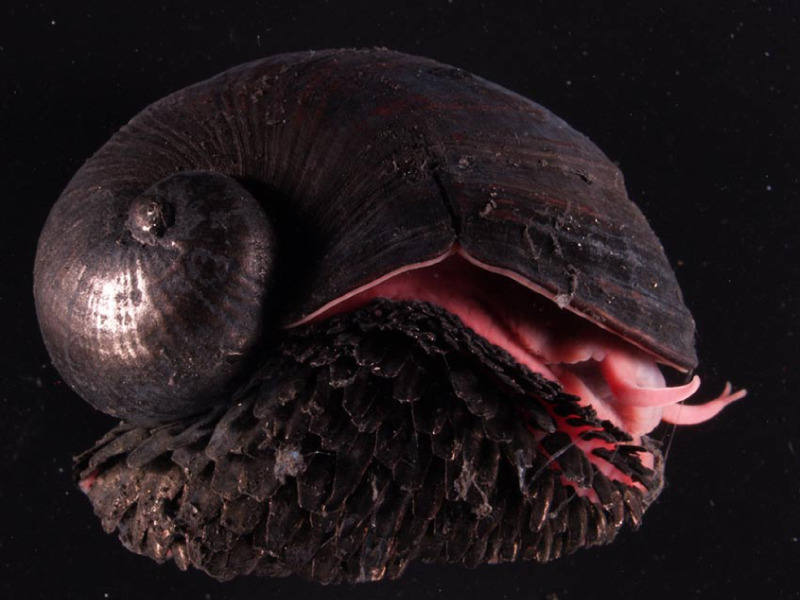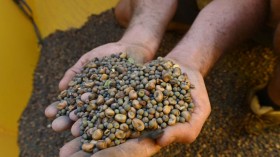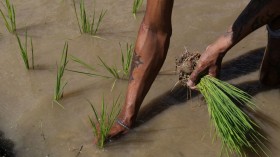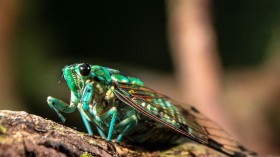It appears like something out of science fiction when you see a golden snail with an iron scale foot. However, these snails are present in a few isolated regions of the Indian Ocean.

scaly-foot gastropod, scaly-foot snail, sea pangolin, or volcano snail
Straight from a Fantasy Novel
Julia Sigwart, a scientist at Frankfurt's Senckenberg Research Institute and one of the few individuals to have seen a living scaly-foot snail (Chrysomallon squamiferum), commonly known as a sea pangolin, says, "It looks like an armored knight creeping around on the deep-sea floor."
The habitat of the snails is harsh. They reside on scorching hydrothermal vents, which may reach more than 300C, and are soaked in deadly chemicals many kilometers below the ocean's surface (572F).
The bacteria developing within a specific pouch in the snails' throats, which transform chemicals flowing out of the vents into energy and provide all of the food, are the center of their whole bodies and way of existence.
Scaly-foot snails developed big gills to capture oxygen and chemicals from saltwater and then carry them to their bloodstream and incredibly large hearts to keep their bacteria well-fed. In proportion, a human heart would be the size of our skulls.
Natural Armor
Scientists discovered in 2019 that the purpose of the snail's foot scales is to prevent poisonous harm from within, not to defend against predatory assault. Sulfur, a popular element in pellets used to kill snails and slugs, is released as a waste product by bacteria stored in the mouth of scaly-foot snails.
The internal structure of their scales functions as microscopic exhaust pipes, taking the harmful sulfur away from the soft tissues of the snails and depositing it on the exterior as a harmless iron-based product.
Scaly-foot snails developed numerous unique adaptations to live atop vents, but they did not count on people being interested in their homes. The three locations where they reside, which would fit inside St. Peter's Square in the Vatican City and cover an area of fewer than 0.025 sq km (0.01 sq miles), may all be used for deep-sea mining.
Also Read: Sighting of Giant African Land Snail Sent Florida County Into Lockdown
Living Near "Treasures" Sites
Mining companies are searching for the gold, silver, and other rare or valuable metals left behind in the rocky chimney walls of the black smokers. The scaly-foot snails would swiftly disappear if their limited habitat were disturbed or destroyed.
The scaly-foot snail was finally listed on the International Union for the Conservation of Nature's red list as an endangered species after Sigwart, and her colleagues assessed the status of these uncommon invertebrates.
It's an effective communication tool, she claims. "Everyone in the world understands what you mean when you say a species is endangered."
Due to deep-sea mining, the scaly-foot snail became the first species in the world to be recognized as threatened. However, specialists have since evaluated and added more deep-sea mollusks to the global endangered list.
Only 25 of the 184 indigenous species that only exist in vents and range in size from enormous clams to a fuzzy snail named after Joe Strummer from the Clash are not thought to be in danger of becoming extinct.
Extremely Rare
Because deep-sea mining is expressly prohibited on vent fields where these species reside, Sigwart says they have remained reasonably safe. This includes the Canadian and Azorean territorial seas and marine protected zones.
Most other species are found in hydrothermal vents in the deep ocean, which are outside territorial waters, less protected, and more vulnerable to mining exploration.
Nobody wants that, according to Sigwart. "These red-list evaluations represent the state and risk to the entire species and its potential to become extinct truly and for us to lose it.
In Sigwart's opinion, these odd mollusks are a fantastic example of how evolution is only about being good enough to survive. According to her, it demonstrates the bizarre and perverse routes that life may travel to adapt and survive.
Related Article: Scientists Use 'Love Potion' to Help Endangered White Abalone Snail Reproduce
For more animal news, don't forget to follow Nature World News!
© 2024 NatureWorldNews.com All rights reserved. Do not reproduce without permission.





